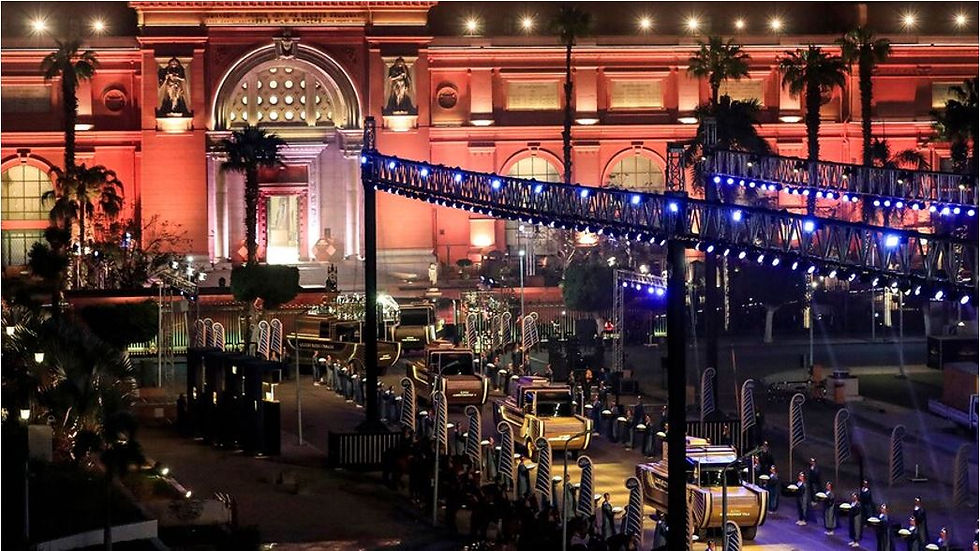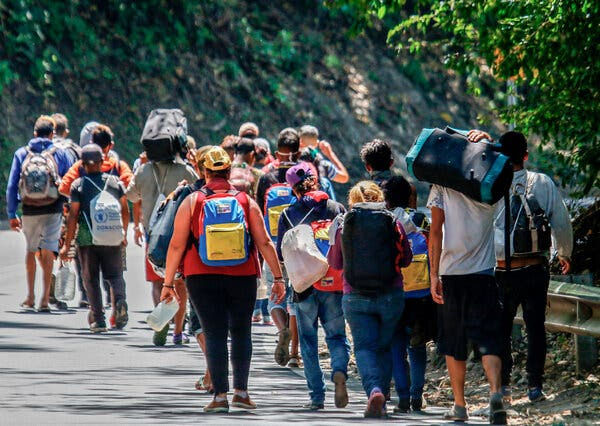Egypt’s Golden Parade and the Danger of Nostalgia
- Alisa Pogrebna-Raizman

- Apr 16, 2021
- 4 min read
Historic Pharaohs’ Golden Parade took place in Cairo on the 3rd of April this year. The event was truly breath-taking. Twenty-two rulers of the New Kingdom, eighteen kings and four queens – including famous King Ramses II and one of the most powerful female pharaohs, Queen Hatshepsut, were transported in shiny personalized vehicles from the Egyptian Museum to the newly opened National Museum of Egyptian Civilization. The multimillion-dollar event was meticulously organized by the Egyptian authorities for months. The grandiose procession was accompanied by performances from the United Philharmonic Orchestra, renowned Egyptian opera singers and artists dressed in mesmerizing ancient Egyptian outfits, with a ceremonial twenty-one-gun salute at the end. Sixty motorcycles and one hundred twenty horses followed the royal mummies to their final destination. The event was broadcast live for spectators all over the world to see.


Why the move?
Royal mummies lied undisturbed for more than a century. So, why the move?
Egypt’s economy suffered one downfall after another since 2011. The Arab Spring and the abolition of then-ruler, Hosni Mubarak, brought a major economic turmoil. A country in which 12 percent of the GDP is reliant on tourism experienced a huge fall of revenue from one of its main sources of income in 2011. The number of tourists dropped by 80 percent in the months after the revolution. A relative revive of the industry happened in 2012, however the coup of President Mohamed Morsi in 2013 hit Egypt’s tourist sector once again. In 2015, when international tourism hit a record mark of 1.2 billion tourists worldwide, Egypt – unlike other Arab states – was not one of the sought-after destinations. Additionally, in September 2015 the Egyptian military mistook a group of tourists for insurgents, killing 12 innocent people. A month later an explosive device placed in a Russian Metrojet airplane caused a plane crash that killed 224 tourists on board. Rising concerns over security decimated hopes for the resurrection of the tourist industry in 2016.
Not long after, there were high expectations for the industry after some relative rise in 2018. However, these were crashed by the COVID-19 pandemic. In 2020, the novel coronavirus disrupted several main sources of revenue – such as tourism, remittances, and the Suez Canal. According to the Ministry of Tourism, Egypt is losing around $1 billion a month just from the paralysis of the tourist industry. From April to June 2020, 2.7 million Egyptians were left jobless due to lengthy lockdowns and the disablement of several sectors of employment.
What does any of this have to do with the mummies?
The parade is the last attempt of the government to attract desired tourists after several years of more downs than ups. Indeed, international media praised the parade for celebrating Egypt’s rich heritage, and hashtag #Egypt_Impressed_The_World began trending on Twitter. Adding to this, the event was also broadcast online and attracted a large audience. This global attention put Egypt in the spotlight.
As the world was captivated by the event, many Egyptians were not allowed to share this moment of “greatness”. Those who came to see the parade were immediately turned back by the police. “If you want to watch, go watch on television” – yelled one policeman. This had nothing to do with coronavirus measurements. Huge banners and flags around Tahrir Square made sure the impoverished areas of Cairo were not visible for online viewers, whereas people who came to witness the historic event were sent to watch the parade on their phones in nearby cafeterias. This reflects on the broader tendency of Egypt to brush aside some of its growing social problems in favor of a presentable facade.
The parade showcased the greatness of Egypt’s past, but unintentionally uncovered its problematic present. Nearly one third of the Egyptian population live below the poverty line. Even though Egypt has seen a decline in poverty for the first time in two decades during 2019-2020, it still leaves the Arab state with an astonishingly high poverty rate compared to its North African neighbors. Many of lower-income Egyptians still haven't recovered from austerity measures coming from a $12 billion IMF loan taken in 2016. As the government is getting ready to receive one more loan from the IMF, another wave of austerity measures is hitting the vulnerable harder than ever. But instead of dealing with the country’s impending issues, Egypt is more concerned with improving its image by focusing on highly expensive large-scale mega-projects – such as the New Administrative Capital. While Egypt’s foreign debt jumped from $48 billion in 2015 to $111.2 billion in 2020, major amounts of those funds are going to be used to finance such projects.
This said, Egypt remains the only North African country to maintain a GPD growth amid the ongoing pandemic. The only problem is that the benefits of economic growth are distributed unevenly. As Egypt is expected to cut social spending, it is getting more and more difficult for people to adapt to the harsh realities of the COVID-19 pandemic. With Egypt’s growing ambition to impress the world, it should happen for, and not on the expense of, its citizens. After all if the Egyptian government believes that mummies will help solving at least one of the country's many problems, I want to hope they are right.
References:
Everything You Need to Know About the Star-Studded Pharaohs’ Golden Parade in Egypt,https://en.vogue.me/culture/everything-to-know-pharaohs-golden-parade-egypt/.
Egypt - Contribution of travel and tourism to GDP as a share of GDP, https://knoema.com/atlas/Egypt/topics/Tourism/Travel-and-Tourism-Total-Contribution-to-GDP/Contribution-of-travel-and-tourism-to-GDP-percent-of-GDP.
Egypt: Luxor tourism faced with toughest crisis since 2011 turmoil, https://www.theafricareport.com/77167/egypt-luxor-tourism-faced-with-toughest-crisis-since-2011-turmoil/.
Can Egypt Overcome Its Travel P.R. Problem?, https://www.nytimes.com/2011/11/06/travel/tourism-in-egypt.html#:~:text=A%20total%20of%2014.8%20million,according%20to%20the%20tourism%20ministry.
K. Tomazos, Egypt’s Tourism Industry and the Arab Spring, March 2017, p. 2. Available at: https://www.researchgate.net/publication/316049640_Egypt's_Tourism_Industry_and_the_Arab_Spring [11.04.2021].
Russian plane crash: What we know, https://www.bbc.com/news/world-middle-east-34687990
K. Tomazos, op. cit., p. 9.
Egypt’s Suez Canal: A ray of light amid the economic gloom, https://www.mei.edu/blog/egypts-suez-canal-ray-light-amid-economic-gloom-0.
Egypt's GDP grows despite pandemic, but so does poverty,https://www.france24.com/en/live-news/20201108-egypt-s-gdp-grows-despite-pandemic-but-so-does-poverty.
Egyptian celebrities steal mummies show in Cairo, https://www.arabnews.com/node/1837606/lifestyle.
Egypt under the spotlight: International media outlets praise the historic Golden Pharaohs' Parade, https://www.egypttoday.com/Article/4/100565/Egypt-under-the-spotlight-International-media-outlets-praise-the-historic.
22 Mummies Are Moved in a Glittering Display in Cairo, https://www.nytimes.com/2021/04/03/world/middleeast/cairo-mummies-parade.html?searchResultPosition=2.
Egypt’s poverty rate falls for the first time in two decades, https://enterprise.press/stories/2020/12/06/egypts-poverty-rate-falls-for-the-first-time-in-two-decades-26212/#:~:text=The%20proportion%20of%20the%20population,2018%2C%20the%20local%20press%20reports.
New austerity measures could hit Egypt’s most vulnerable hard, https://www.mei.edu/blog/new-austerity-measures-could-hit-egypts-most-vulnerable-hard.
Egypt's GDP grows despite pandemic, but so does poverty, https://www.france24.com/en/live-news/20201108-egypt-s-gdp-grows-despite-pandemic-but-so-does-poverty.
New austerity measures could hit Egypt’s most vulnerable hard, https://www.mei.edu/blog/new-austerity-measures-could-hit-egypts-most-vulnerable-hard.



Comments